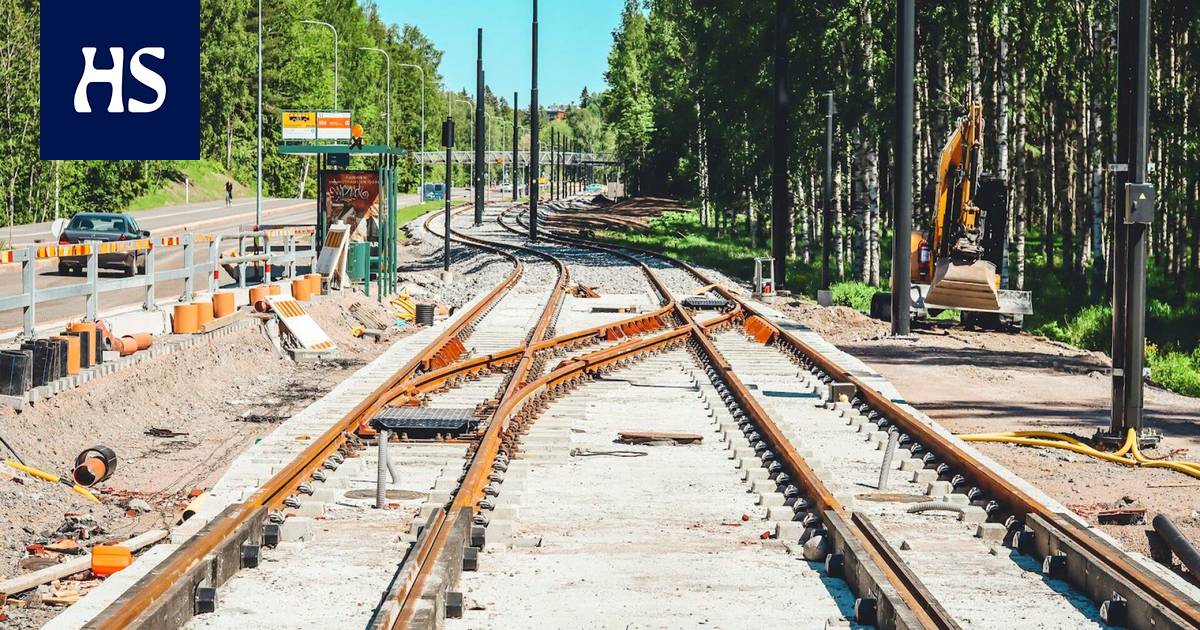New rails are now being planned for Helsinki, Espoo and Vantaa. Low-emission trams are favored for climate reasons, among other things.
In the metropolitan area more trams are being built and planned right now than in decades.
The Raide-Joker contract is nearing completion, construction of the Kalasatama – Pasila tramway and the Laajasalo tramway is in its infancy, and the design of the Vihdintie and Viikin – Malmi tramways is in full swing.
Vantaa is planning the first tram line in the city’s history, and in Espoo, the city’s first trams will start running in 2024 on the Raide-Joker route from Keilaniemi via Leppävaara to Helsinki’s Itäkeskus.
What makes tram traffic so superior that at least some decision makers prefer more and more routes? Is there a nationwide network of trams in the metropolitan area?
And how are all projects paid for correctly?
Low emissions tram transport is popular for climatic reasons, but also because it has proven time and time again to be an effective way to steer the construction of society for decades to come.
Once the tracks are in place, they will not leave in a hurry, which will attract builders and financiers of housing and business premises.
Director of Land Use in Helsinki Rikhard Manninen says rail investment has proven to be an effective driver of public transport.
“For the passenger, the tracks are clear and easy to understand from the user’s perspective. We also talk about the concept of “frequency is freedom”: we can live without a schedule. ”
The Manninen team has bracketed land use revenues along the Viikin – Malmi tram line. The estimate at this stage of the planning is approximately EUR 200–300 million, but the Lahdenväylä arm, for example, will be examined in more detail.
Raide-Jokeri has repeatedly surprised with its productivity. Even before construction began, the prices of old dwellings in the vicinity of the route rose by about six per cent more than further away from the rails.
“We just organized a tender for certain plots in Oulunkylä. The offers were much higher than we expected, ”says Manninen as an example of the influence of Raide-Joker.
Read more: Housing prices have already risen sharply: This is how the new tramway will change the housing markets in Helsinki and Espoo
Based on a recent consulting estimate, Vantaa is also expected to receive revenue from the city’s treasury.
Read more: Consultant’s estimate: Vantaa could get up to half a billion euros from the construction of the tramway track – the most money is wasted at Aviapolis, Tikkurila and Hakunila
Director of the Helsinki Urban Environment Division Ville Lehmuskoski sums up the future prospects so that all the largest urban development sites in Helsinki are always built along rail traffic. This is also outlined in the city’s master plan.
Also the Director of Urban Planning in Espoo Torsti Hokkanen talks about rail transport as the backbone of future urban development. Railways allow cities to direct construction to areas of their choice.
“Tracks are not just a means of moving,” says Hokkanen.
Tramway however, construction costs money, though not as much as building a subway. The 25-kilometer contract price for the Raide-Joker is 386 million euros, while the 21-kilometer western metro costs well over two billion euros.
Correspondingly, a 20-kilometer four-lane highway between Mikkeli and Juva Nuuttilanmäki cost almost EUR 70 million, according to the Finnish Railways.
In the Helsinki metropolitan area, opportunities are being sought to sell plots of land and enter into land sales agreements to cover the construction costs of trams.
The downside of more intensive construction is that the speed targets for projects advertised as high-speed rail may not be met.
In his diploma thesis approved at Aalto University in February Speed of light rail Henri Miettinen notes that the target of 25 km / h for the Raide-Joker has remained subordinate to land use targets. In various simulations, this goal has not been achieved and has hardly guided route planning.
In Viikki, for example, Raide-Joker’s alignment on Viikinkaari is significantly slower and more expensive than alternative alignment on Viikintie. However, the alignment could not be moved to keep the Viikki Science Park stop in a central location.
In Espoo, the Vermonniity stop was needed to serve Vermo’s new area of thousands of residents.
In Vantaa The route from Helsinki’s Mellunmäki via Hakunila and Tikkurila to the airport has not been advertised as a high-speed rail, but as an urban development project and an increase in the capacity of a busy bus line.
There is no consensus among decision-makers on the project, and decision-making next year is expected to be rigorous.
The general plan of Vantaa envisages the branching of the tram line from Pakkala to the west towards Myyrmäki. However, no continuation is planned, as there is no construction decision for the first project either.
Chairman of the Vantaa City Environmental Committee Anssi Aura (kok) is in favor of clarifying the western branch of the tram line. A continuation from Pakkala towards Myyrmäki would be a natural direction.
“From Vantaa’s point of view, it would be natural to find out about the second phase. The whole process should get moving, ”says Aura.
He leaves the exact alignment to professionals, but wonders whether Myyrmäki could be a connection to the terminus of the Helsinki Vihdintie light rail line in the direction of Kannelmäki or perhaps in the direction of Espoo.
Vantaa’s Ylästö is a residential area dominated by detached houses, which is crossed by the narrow and congested Ylästöntie. Anssi Aura leaves the western branch of the tram to the design professionals.
Light rail The extension from Kannelmäki to the north has also been outlined on the Helsinki side, but this connection is not yet planned.
Instead, in the future it could be possible to lift the current 560 trunk bus line from Myyrmäki via Malmi to Eastern Helsinki. Among the designers, this has been named Joker 2.
Before that, the Viikin – Malmi light rail line will be completed, from which a connection to the Vantaa tramway via Jakomäki has been outlined.
A preliminary master plan for this Viima tram was completed last year, and the project will be discussed by politicians in the fall of 2023.
In Espoo The city’s second tram connection from Matinkylä via Suurpello and Kera to Leppävaara has been outlined. In Leppävaara, it would be connected to Raide-Joker and Rantatara.
Espoon According to Hokkanen, Director of Urban Planning, a preliminary master plan for the Matinkylä – Leppävaara tram line has been completed. The continuation from Leppävaara to Vantaa has also been studied to some extent.
“Basically, this would be the second tram connection in Espoo after Raide-Joker, but it could only be relevant sometime in the 2030s,” says Hokkanen.
Espoo politicians are blamed for the tram projects. Chairman of the City Council Henrik Vuornos (kok) pondered In an opinion paper by Länsiväylä magazinethat raising the Matinkylä – Leppävaara distance to the rails would accelerate Suurpello’s job development.
After the heavy western metro contract, the rail money for the next few years in Espoo will be directed to train traffic investments, of which the off-road works between Leppävaara and Kauklahti are scheduled to begin in the autumn of 2023. The large construction site is not expected to be completed until 2028.
#Rail #transport #huge #tram #boom #started #Helsinki #region #factors #rail #construction #attractive








